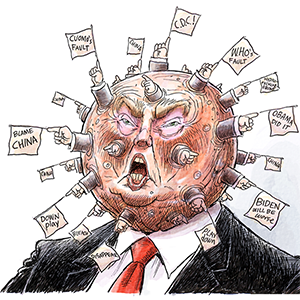Health
/ArcaMax

Democrats Hand The Administration Another Win With Cannabis
Democrats hand the administration a huge cannabis win due to their inability to understand voters
For more than a decade, cannabis reform has stood out as one of the few political issues with overwhelming bipartisan support. Recent surveys show nearly 88% of Americans are open to expanded legalization or meaningful reform, including ...Read more

Who Is Rep. Andy Harris And Why Does He Hate Cannabis
Who is Rep Andy Harris and why does he hate cannabis, his role in blocking rescheduling and shaping federal marijuana policy debates. While the marijuana industry holds its breath on whether the President will finally take long promised action, a new foe has emerged. Who is Rep Andy Harris and why does he hate cannabis. Harris (R-Md.) is a ...Read more

What Does Cannabis Rescheduling Mean
What does cannabis rescheduling mean for patients, doctors, retailers and small businesses as the President weighs federal action.
The last few days have been a rollercoaster for the cannabis industry with a press release was released on Friday saying the President is going to use an executive order on cannabis. The market soared and then ...Read more

Cannabis Faces Headwinds Despite Rumors
Cannabis faces headwinds despite rumors of White House action, as congressional opposition threatens meaningful federal reform.
Last week, the cannabis market soared after rumors the President would take action on cannabis. Stocks rose as it seemed the administration was listening to the public with public opinion decisively in favor of ...Read more

The Feds Cannabis End Of The Year Actions
As 2025 closes, the feds cannabis end of year actions tighten hemp and THC rules, leaving CBD companies and consumers navigating a new federal landscape. The Federal government is up to its armpits with Venezuela, tariffs, building projects and more. As 2025 draws to a close, what are the feds cannabis end of year actions? The government has ...Read more

How Cannabis Can Help With Jet Lag
Learn how cannabis can help with jet lag using CBD, THC and microdosing tips for smoother travel transitions. Whether or seasoned or newbie globetrotters, jet lag can be the unwelcome souvenir which lingers long after the flight. Whether you’re crossing the Atlantic for business in London, shopping in Chennai, hopping to Hawaii for sun, or ...Read more

What To Know About Green And BlackOut Wednesday
Here’s what to know about Green and Blackout Wednesday, the biggest pre-holiday celebration and how to enjoy responsibly. Thanksgiving is upon us with cooking, shopping, family and expectations. It is a werired work which includes prep, work and so much more. But what to know about Green and Blackout Wednesday. This week comes with two ...Read more

Traveling With Cannabis And CBD
Holiday guide to traveling with cannabis and CBD, microdosing gummies, easing family anxiety, navigating airports smarter. The holidays are prime travel season — packed airports, crowded train stations and frayed nerves as families reunite. With the stress, what about traveling with cannabis and CBD. After all, they serve alcohol on the plane...Read more

What The Bible And Early Christianity Say About Cannabis
Renewed interest in Turkey’s Nicene Creed anniversary highlights debates over what the Bible and early Christianity say about cannabis. Religion is in the headlines again as the anniversary of the Council of Nicaea (and Pope Leo’s trip) and renewed interest in the Nicene Creed spotlight how early Christian leaders shaped doctrine still ...Read more

What’s Up With Marijuana Pouches
From ballparks to boardrooms, people are buzzing about a new way to chill — what’s up with marijuana pouches? A discreet new cannabis trend is making its way from dispensary counters to golf bags, office drawers, and weekend festivals what’s up with marijuana pouches. These tiny, tea-bag-like packets are designed to deliver THC or CBD ...Read more

Who is Rep. Thomas Massie And Why It Matters For Cannabis
Discover who is Rep. Thomas Massie and why it matters for cannabis policy, hemp bans, and legalization Who is Rep. Thomas Massie and why it matters for cannabis? He is the libertarian-leaning Republican congressman from Kentucky’s 4th District who has built a national reputation as an independent, tech-minded lawmaker willing to buck party ...Read more

What About A Cannabis Cocktail/ Holiday Party
Hosting a winter gathering? What about a cannabis cocktail/holiday party. It is the chic, hangover-free way to celebrate. As the holidays approach, dinner parties and happy hours begin filling the calendar — often with a predictable lineup of wine, cocktails, and morning-after regrets. But this year, a new trend is quietly taking over living ...Read more

Another Benefit for Cannabis Users
Joining thousands of mom-and-pop businesses and American households, cannabis is another industry hit hard by the shutdown As more Americans reexamine their relationship with alcohol, a growing number are discovering another benefit from cannabis users. The green plant might offer a surprising nighttime benefit — better, more restful sleep....Read more

Mexican Food And Marijuana
From fiery tacos to creamy guacamole here how marijuana enhances Mexican cuisine and tips on the perfect strain for your meal.
Cannabis enthusiasts and food lovers alike have long known marijuana can heighten the senses, making ordinary meals feel extraordinary. And when it comes to pairing cannabis with cuisine, what is better than Mexican ...Read more

Does Jonathan Bailey Consume Weed
Does Jonathan Bailey consume weed? Inside the Sexiest Man Alive’s candid reflections on fame, sobriety, and self-discovery.
When People magazine crowned him as its 2025 Sexiest Man Alive, it seemed a natural step for the 36-year-old British actor whose blend of charm, talent, and authenticity has captivated global audiences. Known for his ...Read more

Cannabis Is Another Industry Hit Hard By The Shutdown
Joining thousands of mom-and-pop businesses and American households, cannabis is another industry hit hard by the shutdown The ongoing federal government shutdown which began October 1, 2025 is reshaping spending behavior in several consumer categories — notably those tied to discretionary goods such as marijuana and alcohol. With paychecks ...Read more

The Idea Developed While Stoned Is Paying Off
From whimsical thought to success, the idea developed while stoned is paying off with major sponsorship. Sometimes those “what if?” ideas starting mid-sesh actually turn into something brilliant. As an example, the idea developed while stoned is paying off for there buddies. Just ask Pete Davidson and Colin Jost. What began as a hazy, half-...Read more

The Feds Foul Play Around Cannabis
The Feds foul play around cannabis exposes misinformation, fear tactics, and how Washington ignores 88% of Americans While nearly 88% of Americans support some form of legal cannabis, the old guard in Washington continues to misrepresent the will of the people. This isn’t a quiet disagreement over policy — it’s a stubborn act of defiance ...Read more

Can Cannabis Help You Survive Daylight Savings Time
Can cannabis help you survive Daylight Savings Time? Discover how it eases sleep, stress, and sluggish mornings
Twice a year, millions of Americans grumble as the clocks shift for Daylight Savings Time (DST). This weekend marks the annual “fall back,” when most of the country gains an hour of sleep, but our internal clocks aren’t always ...Read more

Cannabis In Candy And Other Halloween Myths
Debunking cannabis in candy and other Halloween myths: what parents really need to know
Curious about the cannabis in candy and other Halloween myths? Every autumn, a familiar rumor surfaces on social media and in group texts: “Someone’s handing out weed candy to trick‑or‑treaters.” But here’s the short version: no credible ...Read more






















